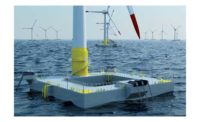While New Jersey towns have seen economic gain from a boom in warehouse construction, especially since the beginning of the pandemic, sprawl of the giant facilities is prompting one regional regulator in the state to enact restrictions. State and municipal governments across the nation are also eyeing the environmental impacts of warehouses, even as some are propelling adoption of green energy technology.
Officials in New Jersey’s Highlands region—an area covering more than 1,250 sq miles and including 88 municipalities in seven northwestern counties—last month issued what is said to be the state’s first regional warehouse curbs, banning the facilities in some areas and setting strict rules for their location and design.
The regional policy is based on the “urgency” of setting limits on warehouse growth, Ben Spinelli, New Jersey Highlands Water Protection and Planning Council, told NJ Spotlight.
The region is close to major state highways that bring goods from points west to the Port Newark-Elizabeth, N.J., terminal, one of the largest U.S. container shipping ports. Larger warehouse facilities—from 500,000 to 1.5-million sq ft—with more automation are generating faster turnover of goods and more truck traffic flow, the council says. Developer Bridge Industrial recently announced plans to build New Jersey’s largest warehouse complex, at an estimated 5.5 million sq ft, on a site that includes wetlands in Mercer County.
The current vacancy rate for warehouse industrial space across New Jersey is less than 2%, with several under 1%, according to 2022 data from global real estate firm Cushman & Wakefield. More than 626 million sq ft of space was under construction in the state in 2022, it said.
'No-Go Areas'
The council’s new regional policy sets “no-go areas” where new warehouses are banned as an “unsuitable use" because of risks to water sources, natural resources, farmlands, woodlands and environmental features. It also sets new rules to minimize impervious surfaces that generate more runoff in a region that supplies 70% of New Jersey’s drinking water.
The policy also restricts warehouse traffic use of local roads, with large projects required to be located within three miles of an interstate highway interchange. The facilities can be built on county roads only if they are within one mile of a state or interstate highway,
The regional policy is based on 2022 state land use guidelines, but it has enforcement teeth that the state document lacks in towns under council jurisdiction. State Sen. Shirley Turner (D-Mercer) introduced a bill last December to provide more legal backing to the state guidelines—set to require municipal planning boards to make their local master plans consistent with the state guidelines related to warehouses, as well as with other state guidance.
Towns also are setting their own restrictions. Mansfield Township in Burlington County banned new warehouse construction under an ordinance approved in March, while officials in Bordentown, also in the county, voted to limit development along the major Route 130 and Route 206 corridors that run parallel to the NJ Turnpike.
Warehouse advocates defend their need. “We are a logistics state, in the middle of a large metropolitan economic and population region,” says Ray Cantor, New Jersey Business & Industry Association Deputy Chief Government Affairs Officer. “What is needed are not efforts to stop warehouses, but for everyone working together to make sure they are properly located near highway systems and otherwise developed to minimize impacts on surrounding communities.”
But other states also are fighting sprawl. A coalition of more than 60 environmental, labor, community and academic groups in California in January urged Gov. Gavin Newsom (D) to declare warehouse sprawl in the state a public health emergency and order a moratorium on development. No such actions have yet been taken.
Solar Energy Potential
Some existing and future warehouses are moving to be more acceptable, offering major solar power deployment potential. Nationwide, over 450,000 warehouses and distribution centers have 16.4 billion sq ft of roof space, according to a report by Environment America, a national network of environmental groups. California, Florida, Illinois, Texas and Georgia have the largest warehouse solar-generation potential, the group says.
“California needs more rooftop solar, and expansive, flat warehouse roofs are the perfect spots for solar panels,” said Steven King, a clean energy advocate with Environment California Research & Policy Center, in the report.
As of 2022, there were 13,267 warehouses in New Jersey, 66,484 in California, 35,385 in Florida and 42,155 in Texas with potential for solar generation, according to Environment America.
The Solar Energy Industries Association said New Jersey is ranked as the eighth-largest solar energy state in the nation, producing 4.27 GW at 170 facilities with solar that accounts for 6.7% of its energy mix as of last Sept. 30.
New Jersey packaging company Sonoco Products in April installed a 1 MW rooftop solar array at its warehouse facility in Dayton in Middlesez County. The new system installed by Novitium Energy will produce nearly 1.3 million kWh of clean power per year and allow the facility to self-generate 58% of its electricity from the solar panels, the company said.




